#my scholarly empire
Text
Revised Game Studies Syllabus for Spring 2023 ("Oops, All Disco Elysium")!
Revised Game Studies Syllabus for Spring 2023 (“Oops, All Disco Elysium”)!
With my new role as chair, I’ve only got one class this term, but it’s a good one: a upper-division version of my Game Studies class, with this term’s special Disco Elysium focus. Here’s the week by week:
DAYDATE ASSIGNMENTWJan 18STARTFIRST DAY OF CLASSFJan 20NARRATIVEGame: The Stanley ParableCorey Mohler, Existential Comics: “Candyland and the Nature of the Absurd”Interview with Davey Wreden,…

View On WordPress
5 notes
·
View notes
Text
Waiting for the 2nd Century Warlord Comic? Want to learn more about ancient china? Check out these fun sources!
Three Kingdoms oversimplified. Exactly what it says on the tin.
Farce of the Three Kingdoms. A hilarious parody of the novel Romance of the Three Kingdoms that is only slightly more bonkers than the real thing (3/10 historical accuracy). For a more factual account, try reading Records of the Three Kingdoms...or just wikipedia-ing everyone.
War of the Three Kingdoms (2010). A fun TV show that deviates a lot from the novel but is more character-driven. has a lot of costume inaccuracies tho which drives me crazy >:((((
Romance of the Three Kingdoms(1994)TV show, considered a definitive classic. Editing's a bit choppy but at least none of the men have their hair down.
Total War: Three kingdoms. History told in the form of a stratagy-based video game.
Tang dynasty football. Not the same dynasty, but it's a nice showcase of costumes and instruments, also a surprisingly concise summary about ancient Chinese politics. (Bribes)
What did Early Middle Chinese sound like? How does one recreate a non-phonetic language?
#romance of the three kingdoms#ancient china#text#san guo yan yi#please join me in the san guo fandom#being chinese is so hard i told my parents i was reading san guo and they were like ah yes a scholarly pursuit how the hell do i explain#to them that im a cao cao appologist and reknown general xu chu is my blorbo?????#me: i don't get political. me: 1 drink later#hear ye hear ye. lui bei the baby-tossing warmonger has nothing going for him except his alleged royal bloodline.#and the fact he's a solid 10#citizens you must support lord cao cao the unifier. up with the glorious wei empire! down with the traitorous shu han!
61 notes
·
View notes
Text



𝐇𝐢𝐠𝐡 𝐕𝐚𝐥𝐲𝐫𝐢𝐚𝐧 𝐏𝐡𝐫𝐚𝐬𝐞𝐬:
Btw this is the best High Valyrian translator I've found.
a/n: some swears lol. If you really want to learn the language, then Duolingo is great!
𝐖𝐡𝐚𝐭 𝐀𝐫𝐞 𝐓𝐡𝐞 𝐇𝐢𝐠𝐡 𝐕𝐚𝐥𝐲𝐫𝐢𝐚𝐧 𝐋𝐚𝐧𝐠𝐮𝐚𝐠𝐞𝐬?
After the "Doom of Valyria", High Valyrian transformed dailly language of an empire into more of a scholarly language kept alive by the elite nobles, poets, and scholars across Essos and Westeros.
𝐁𝐚𝐬𝐭𝐚𝐫𝐝 𝐕𝐚𝐥𝐲𝐫𝐢𝐚𝐧 𝐎𝐫 𝐋𝐨𝐰 𝐕𝐚𝐥𝐲𝐫𝐢𝐚𝐧
Each of the Nine Free Cities developed their own distinct Low Valyrian tongue like the Braavosi, Lorathi, Lysene, Myrish, Norvoshi, Pentoshi, Qohorik, Tyroshi, and Volantene.
So while High Valyrian remained the sacred, elite lore language, these Low Valyrian offshoots became the common tongue.
It's probably why it's so difficult to get the exact wording right when there's so many different versions of one language.

𝑨𝒏𝒚𝒘𝒂𝒚, 𝒉𝒆𝒓𝒆'𝒔 𝒂 𝒇𝒆𝒘 𝒑𝒉𝒓𝒂𝒔𝒆𝒔!
Blood of the Dragon = Zaldrīzo ānogar
Game of Thrones = Tymptir Dēmalȳti
Freedom = Dāerves
Ñuhor līr gūrēnna = I will take what is mine.
Ao ynoma dīnilūks? = Will you marry me?
Valyrio muño ēngos ñuhys issa = Valyrian is my mother tongue.
My name is (name). = Ñuha brozi (name) issa
Seven Hells! = Sīkudi nopāzmi
I love you. = Avy jorrāela
Mother of Dragons = Muña Zaldrizoti
Prince = Darilaros
Twin = Idaña
Older Sister = Mandia
Younger Sister = Hāedar
Older Brother =Lēkia
Younger Brother = Valonqar
Wolves = Zoklī
Cats = Kēla
Small = Byka
𝐃𝐫𝐚𝐠𝐨𝐧 𝐂𝐨𝐦𝐦𝐚𝐧𝐝𝐬 🔥
Dragon = Zaldrīzes
Dracarys = Dragon-Fire
Dohaeras = Serve
Lykirī= Be Calm
Naejot = Forward
Umbās = Wait
Ynot! = Come! (to me)
Daor! = No!
Vēzot! = Up!
Rȳbās! = Listen! Obey!
Ninkiot! / Parmot! / Tegot! = Land!
Gevī! / Hegnīr! = Good!

#high valyria#high valyrian#old valyria#high valyrian phrases#dracarys#valyrio#game of thrones#house of the dragon#old valyrian cultures#asoiaf#house targaryen#house velaryon#house celtigar#before the doom#dragonriders#house of the dragon languages#lykiri#aemond targaryen#dragons#vhagar#balerion#meraxes#the cannibal#caraxes#meleys#silverwing#vermithor#syrax#vermax#arrax
424 notes
·
View notes
Text
Doing a deep dive into the history of Zoroastrianism and Manichaeism. I may be a classicist by training, but I've come to realize that you can't fully understand the Roman Empire--especially religious movements in the Roman Empire, which is my chief scholarly interest right now--without understanding Rome's Persian neighbors, the Parthians and later the Sassanids, and how they saw the world. Of course, this means I've fallen yet farther down the intellectual rabbit hole, but who wants to climb out anyway?
72 notes
·
View notes
Text
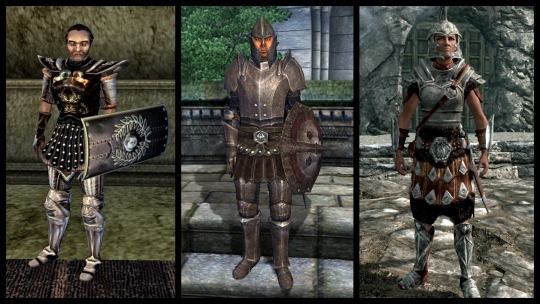
It’s kinda funny how the elder scrolls game with the least amount of Roman Empire influence in the imperial armor is the game where you go to the seat of the empire
The Morrowind imperial soldiers even have a Roman style shield. The Skyrim helmets and skirt style in particular are also quite reminiscent of Roman soldiers armor.
The oblivion guy has a lil skirt over his armor and that’s about it. Oblivion armor is much more medieval inspired. And the reason I find that interesting is that Oblivion has the imperial city in it as well as a huge wine industry. It’s heavily implied to be basically fantasy Rome. And the attire of the people in Cyrodiil could be considered similar to the late Roman Empire when shirts and pants became more common across Europe and idk we can call the mages robes continuing influence of old fashioned clothes in scholarly spaces or something I dunno
Clearly Oblivion wants to be medieval Europe even though every other game in the series treats it like Ancient Rome.
Sorry I’m abnormal about Rome and my current hyperfixation has been clashing with that for a while now and I had to get it out of my system
35 notes
·
View notes
Note
Chaco as a military state- what?? What grounds is that theory using??
Steve Lekson is a genuinely respected Chaco archaeologist with a... very idiosyncratic proposal about its social organization, which I am never sure how much he seriously believes and how much he puts forward to be provocative on purpose.
I think he put forward his idea of Chaco Canyon as the seat of a true state with the ability to muster a military to enforce the alliances with other Great House outliers back when it was more popular to view Chaco as a much more communal religious pilgrimage location. He posited the Great Houses as elite spaces akin to palaces, with their displays of wealth and power and evident ability to organize vast amounts of labor to build them, and the Chaco Roads serving a similar function as Inca or Roman roads: allowing the ability to muster forces and move people and supplies across the landscape quickly. He interpreted elite control over exotic and valuable goods as evidence of a much stronger and more centralized control over the political sphere, and outlying Great Houses not as individual organizations mirroring and claiming Chacoan power for their own communities but impositions of a Chaco worldview from the Canyon as center. and this was even before the DNA study where we learned about matrilineal elites/rulers!
Genuinely can't tell how much he believes it, vs. how much it's the academic version of performance art where he' says's saying to the Establishment, "you wanna believe in hippy-dippy Chaco soooo bad. What if they were a state? What if they did rule by imposed hierarchical coercion? What if the outlying Great Houses weren't a voluntary alignment with Chacoan ideology but an imposition of it by force? Why do you think there couldn't be a North American empire? Does that challenge your ideas of Chacoans as peaceful religious noble savages too much?" He has a very well-written and thought-provoking chapter in The Oxford Handbook of Southwest Archaeology about the need for scientific imagination and narrative history. It begins like this:
A colleague once told me that it was impossible to write a narrative history of the ancient Southwest. So I wrote one. In my narrative (Lekson 2009), there were rises and falls, triumphs and tragedies, nobles and commoners, war and peace, cities and countrysides—tropes of history everywhere in the world—but these almost never appeared in scholarly accounts of the ancient Southwest. And that was the polemic of my history: American anthropological archaeology denies to Native societies north of Mexico any significant history (Lekson 2010). Just a few notable events, mostly natural: a drought here, a collapse there, a migration or two, and so forth—but no kings-and-battles history, nothing for narrative.
It's a political stance as much as it's an archaeological claim, and he has been annoying other Chaco specialists for decades with this.
#I respect his stance but not his interpretations lol#I do think Chaco is weirder and more unique and more Puebloan than that#There's also just not a lot of evidence for violence during the height of Chaco. And religious/ritual sodalities ruled through matrilines#and outlying Great Houses trying to align themselves with that power also make a very interesting history and fit the evidence rather bette#He also IS a very good writer#We need more good academic writers#He's just using it for this stuff. Positing kings and battles and the Chaco World as an empire#asks#iamthepulta#archaeology#Chaco Canyon
18 notes
·
View notes
Text
My best guesses on which cultures/countries Tamora Pierce bases her places and peoples off of. Obviously these aren't perfect copies, but more of where the idea may have come from.
Tortall is definitely Europe. Knights, castles, European names like John and George, ect. Easy.
Bazhir Desert: this one is trickier. Very likely based on Arab deserts or the Sahara and the peoples who live there. It's very ambiguous, just a basic desert culture, not a ton of world building here, but it's been a long time since I've read the Lioness books.
Galla and Scanra: I believe these are both based off Northern countries, with Scanra definitely based on Viking culture. Galla is less so, more like Lithuania or Poland, but neither is Russia. We will get to Russia in a bit.
Sairen and K'miri: Definitely Mongolia and steppe people and place.
Roof of the World: Tibet
Carthak: Egypt. Definitely based on ancient Egypt. Crocodiles, hyenas, lots of gold and darker skinned people. Old, powerful and center of learning.
Yamani Islands: Japan. I don't need to elaborate.
Copper Isles: This one I think is a bit of a mix of Indonesia and Hawaii.
Now, for Circle of Magic! (aka the fun and interesting culture and worldbuilding)
Emelan and the Pebbled Sea: Definitely Mediterranean, but I'm not sure which. My best guess is a sorta Turkey/Persian influence. It's not as obvious as Tortall. I believe the Chandlers and Tris are from a more Italian culture, probably from a country up North, but close enough to border Emelan and making travel easy. The whole merchant family thing made me think of Italy.
Traders: Likely based of Roma/Romani people. Trading caravans and largely persecuted. Not an exact copy, but similar.
Namorn: Russia! Definitely Russia. Large empire, very cold, far north and uses vaguely Russian terms. Powerful and not to be messed with.
Tharios: This one was tricky and fascinating. Probably ancient Greece, but I believe there were some other influences. The world building was massive as the plot directly involved the culture of the city. We also view the city from the scholarly but judgemental eyes of Tris.
Chammur: My best guess is India. Briar is more concerned with gangs and Evy so he doesn't really let us see the city as well. But India seems like a fair bet.
Yanjing: China. No needed discussion here lol.
Gyongxe: I'm guessing Tibet, again. The Roof of the World was way too quick, so Im glad Tamora re-visited this culture in a better way. Who knows, the Shang Dragon was very Chinese inspired, maybe Alanna did travel that far and missed Briar, Rosethorn and Evy by a few years! I'm still firm in the belief that all the books are in the same world.
If you agree or disagree with my picks, feel free to comment and propose your own theories! Or if I missed a country.
#circle of magic#tamora pierce#tortall#emelan#pebbled sea#the cirlce opens#will of the empress#books#fantasy books#book reccomendation#culture and worldbuilding#worldbuilding#fandom theory#fandom#long post
99 notes
·
View notes
Text
I wrote a post trying to figure out why on earth some Pagans & Witches refer to Imbolc (an Irish spring agricultural holiday associated with St Brigid, a potential Christianization of the Goddess Brigid/Bríg) as Candlemas, the completely Christian holiday celebrating The Purification of Mary & Presentation of Jesus at The Temple— which originated in the eastern part of the Roman Empire (which the only "pagan" aspect was it competing with Roman Lupercalia for celebrants).
Many pagan & witch spaces online have a constant disdain for Christianity thus I could not wrap my head around them using such an important point of Jesus' & Mary's life as one of their festivals/'sabbats'.... then, after writing a bunch of stuff, I stumbled onto the answer on Wikipedia's Wheel of The Year page, which has citations for its claims:
Margaret Murray (very early 20th century scholar) in her now discredited witch-cult hypothesis said that the Scottish "witch" Issobell Smyth in 1661 confessed to attending meetings for witches on the cross quarter days included Candlemas. Robert Graves (oh how I loathe you ehem I mean: poet folklorist), mentioned that Candlemas was part of the 8 ancient British agricultural festivals. And Doreen Valiente ("The Mother of Wicca") included Candlemas in her list of Greater Sabbat Fire Festivals, while also listing "Gaelic counterparts," in this case Imbolc.
Sigh.
Early (read: 19th-20th century) paganism and witchcraft, or scholarly work about it, really was just: put every claim regardless of accuracy from any culture in this jar, shake it up real good, see what pops out from the mix, then pretend its historically attested to and traditional despite any and all evidence.
Also whatever Wikipedia writer wrote this, I appreciate your sassiness ... even if it was unintentional:
Due to early Wicca's influence on modern paganism and the syncretic adoption of Anglo-Saxon and Celtic motifs, the most commonly used English festival names for the Wheel of the Year tend to be the Celtic ones introduced by Gardner and the mostly Germanic-derived names introduced by Kelly, regardless whether the celebrations are based on those cultures.
EDIT: To be clear, not all neo/pagans, witches, wiccans, occultists, people-who-use-wheel-of-year are anti-Christian! I'm not trying to say that. But as a worshipper of Mary now, I notice it more and more. Nor am I saying all those people follow Murray/Grave/Valiente blindly but published works and trusted blogs often seem to. This is simply an observation, I've taken notice of, its not the entire communities.
#wheel of the year#imbolc#imbolg#candlemas#pagan#neo pagan#polytheist#witch#annoying history#theres a great post on the actual irish holidays from ya know an irish perspective#but i cant find it#holiday#mariolatry#first sorrow#deletes previous draft#should have just read wheel of year article first#letsdebunk#tag seems appropriate i guess
40 notes
·
View notes
Text
This is important, so I wanted to spin this off into a new post to discuss.
@glorioustidalwavedefendor sent me a very good article about a former RBT (registered behavioral therapist) about how he thought he was doing “good” with Applied Behavior Analysis (ABA), until…
(please do pay attention to the trigger warnings in the article, they are there for a reason)
The issue with ABA, in my opinion, can be really summed up by the first point in the previous Code of Ethics for the Behavior Analysts Certification Board for the USA:

1.01 Reliance on Scientific Knowledge
Behavior analysts rely on professionally derived knowledge based in science and behavior analysis when making scientific or professional judgments in human service provisions, or when engaging in scholarly or professional endeavors.
Not “Do no harm.” Not “we consider the needs and vulnerabilities of our clients.” Not even “Benefit Others,” which is the first principle in the first section of the current Code of Ethics, “Core Principles.”
The Code of Ethics is focused on the fact that ABA is about science, they are scientific, and therefore they are right.
Despite the mounting evidence of the empirical data they blatantly ignore (e.g. visible signs of trauma in clients) because it does not fit into their own specific definition of “important.”
The issue with ABA is the philosophy that is taught to analysts, reinforced and hammered in until it is accepted: We are doing good, and therefore we do not need to be questioned.
Anyone who stops believing in this, stops being a behavior analyst, simple as that.
The Professional and Ethical Compliance Code for Behavior Analysts, copyright 2014 and in effect from January 1, 2016 to January 1, 2022:
Ethics Code for Behavior Analysts, copyright 2020 and in effect as of January 1, 2022
#tw aba therapy#core principles#core philosophy#aba is rotten to the core#because they believe the are infallible#simple as that
17 notes
·
View notes
Text
THE ILIAD: FOR DUMMIES ☀️ MASTERPOST
just kidding you're not a dummy, you're some hot stuff right there!
i will be going through the entire iliad and giving you a general overview, some interesting plot points, additional context, and some other analysis tools to better help you understand the epic!
This post will serve as a table of contents (at the end) to my Iliad posts and a general overview that I will be constantly updating! I am using the Richmond Lattimore translation of the Iliad, alongside my companion book by Malcom M. Wilcock
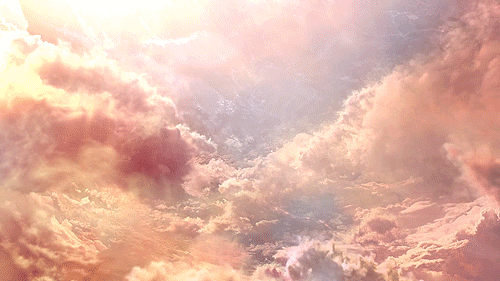
Before we get into analyzing the actual Iliad, we need to get into some essential questions and context about the book
WHAT IS THE ILIAD:
The Iliad was written by Homer (this is actually debated but we can get into that later) around 750 and 550 B.C.E.
At its core, the story is about heros and humans. It's an Iron Age poem about an event, the Trojan War, that was supposed to have taken place in the Bronze age. The Iliad is considered to be a poem comprised of multiple books, 24 to be exact
This story is only a few days of the tenth and final year of the Greek siege against the city of Troy- this means it relies on the audience already knowing most of the basic details about the Trojan war and the gods themselves (don't sorry, I will provide this for you as we go along)
WHO IS HOMER:
The age old question: who the fuck is Homer?
Literally nothing is known about this dude except that he wrote (or was credited with writing) the Odyssey and the Iliad
People have referenced his writings for EONS. Archilochus, Alcman, Tyrtaeus, Callinus, and even Sappho have referenced the poems of Homer in their own works. These also were popular in fine art in the late 7th century B.C.E.
There is a general consensus that Homer was from Ionia- a territory in western Anatolia or modern day Turkey that was populated by Greeks who spoke the Ionian dialect, aka the birthplace of Greek philosophy. Want more info on Ionia? Click Here!
His descendants were called the Homerids/Homeridae
There is scholarly debate on if he even wrote both the Iliad and the Odyssey, or if he only wrote one, etc etc etc. This is due to some very specific differences in the structure of the words used (like the use of short vowels, and the seemingly unimportant semivowel of the digamma being missing from the epics...yeah it's a lot)
The poems were reproduced ORALLY. This means that the poems were passed down by word of mouth, which if I were to sit and listen to this entire book via a guy singing at me...idk man I think I would leave
All of this to say, we really don't know who Homer is. There's a lot more information about what he could have looked like, if he really did write the Iliad, and a million other things, but I've already talked your ear off and we haven't even gotten into the book yet. If you want more information about Homer, check out my sources at the end of the post!
WAS THE CITY OF TROY REAL:
Yeah. There were nine layers exposed at the site of where Troy was expected to be, and nearly fifty sublayers at the mound of Hisarlik
Troy was a vassal state: meaning it had an obligation to a superior state, which happened to be the Hittite Empire
Troy had a lot more allies than original fighters in the city, meaning they had many language barriers- making the army harder to control than the unified Greek enemy.
THE STYLE OF THE ILIAD:
Cause - Effect - Solution
The poem is concluded with a mirror image of its beginning: an old man ventures to the camp of his enemy in order to ransom his child
The poem foreshadows the death of Achilles in MULTIPLE passages! He knows he is destined to die young if he fights at Troy, and the demise of his lover (don't fight me on this) Patroclus gives us an even more extended foreshadowing of the grief that is to come
When Achilles dies, Thetis (his mom) takes his body from the pyre and takes him to a place called the White Island. It's not clear whether he is immortalized BUT the reference to Achilles funeral in the Odyssey states that Achilles is cremated and his bones are placed in a golden urn along those of Patroclus, and the urn is entombed under a prominent mound (tsoa fans...you're welcome)
This isn't really necessary knowledge but moreso something I think is cool: the backstory from the Iliad of an abducted bride also appears in the Sanskirt epic Ramayana (circa 4th century B.C.E.)
okay now here is the ACTUAL important stuff
Humanity is the center of the universe in the Iliad. Humans motivations and concerns generate action in the poem, while the gods are often reduced to the role of enablers or spectators
The style of the poem collaborates with the vision that the speciousness of this epic means that every thought and gesture, spear cast and threat, intimate conversation and lament CAN be recorded. It gives a consciousness behind the demands of the iliad that these interactions MUST be recorded, this attention to detail is another way of showing centrality and the worth of the human experience (Greek OR Trojan)
The Iliad is ultimately a poem about death, the chief elements that distinguish the mortals from gods are: Death shadows every action, and death is neither abhorred nor celebrated. Instead it crystalizes by means of this one theme, death in battle, the essence of what it means to be human (Life is a struggle each person will always lose, the question is how one acts with that knowledge)
Modern readers and analysis blogs will state that one's inner spirit is somehow the "real" self, however the Iliad assumes the opposite: The psykhai (soul, spirits) of dying heroes fly off to Hades while their autous ("selves") are left behind in the form of dead bodies
Glory is INCREDIBLY important in the iliad, why? If mortals could live forever (like gods) then glory would be useless. It's a commodity to be exchanged, and because of this it has an economic and symbolic reality
Companionship is incredibly important
Pity is also very important, it's the concluding note of the poem. Even the gods feel pity
THE GODS AND THE ILIAD:
The Iliad gains depth by the divine dimension shedding glory on the humans at Troy. The gods are so intensely concerned with warriors and their fates which elevates the mortals to a special plane
Mortals are only separated from gods because they grow old and die
The symbiotic bond of gods and mortals is always see-sawing between adoration and antagonism
Humans who get too close to the gods risk being struck down, case in point, Achilles. He's young, well-made, he's a warrior but also a singer/musician (the only hero to be seen doing such a thing), he looks and acts like Apollo. THEREFORE...it's no coincidence that Apollo is ultimately the god who slays Achilles, just as he did Patroclus
Poetry supplemented or even guided ancient Greek religious interpretation much more than the activity of priests due to the lack of any official religious text. This gave ancient Hellenism a very fluid nature
This was a long post, and it's only the first of many! I will continuously update this with more sources about the Iliad and answer any FAQs that come up! I love classic literature, and as a STEM student I need to entertain my passion somehow lol. There is a table of contents at the top of the post, as well as right here. This will be updated for each book of the Iliad I write about, as well as any supplemental posts I make about certain topics and themes as I go along. I am putting a LOT of work into this series of posts, so let me know your thoughts or anything you'd like me to change/add/etc! Happy reading!
TABLE OF CONTENTS:
(This is empty because this is the only post...more posts coming soon)
Sources/Citations/Additional Material
Homer- Britannica
Homerids- Britannica
Who Is Homer- The British Museum (fuck the British Museum)
Ionia Information- World Encyclopedia
The Hittites- Britannica
Ramayana Overview- British Library
Overview of Greek Mythology- Theoi
The Iliad- Overview via Britannica
Thetis- World Encyclopedia
#greek mythology#hellenic pagan#hellenism#pagan#helpol#deity worship#the iliad#homer#greek myths#greek#literature#the iliad analysis#iliad#iliad readthrough#iliad analysis#greek myth#academic content#masterpost#iliad masterpost#greek mythology masterpost#witchblr#hellenic#citations#homer's iliad#trojan war#the song of achilles#bookblr#analysis#book analysis#poems
109 notes
·
View notes
Text
Tenmaku no Jadoogar: A Witch’s Life in Mongol - 天幕のジャードゥーガル
HISTORICAL, DRAMA
Tenmaku no Jadoogar: A Witch's Life in Mongol by Tomato Soup
(1 volume, ongoing)
JP only. Hopefully, it gets licensed! Please hire me to translate this, publishing companies. The first 5 chapters are up for free in JP here.
Links to my other manga posts here
An Irani girl named Fatima who’s a captive of the Mongol Empire and uses her education to her advantage???
Hello, my name is Fatimah, I’m half Irani, and it’s finally my time >:)
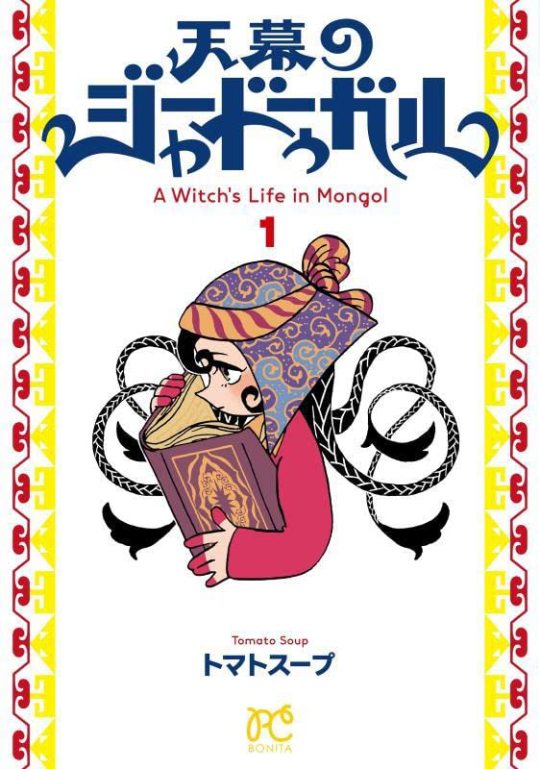
I hope you guys are ready for history and cultural lessons! I worked really hard on this post and she’s a long one... I literally just came back from an Iran trip and got some books, took pictures, and consulted people who know more than me for this post (the trip wasn't for the post, that was a coincidence lolllll).
This series won first place in the オンナ編 (Female Category) for the このマンガがすごい!2023 / Kono Manga ga Sugoi 2023 / “This Manga is Amazing! 2023″ which is a rather prestigious award. I’ve talked about the Male Category’s 1st, 2nd, 3rd place winners (2nd place will have a dedicated post one day), and plan to talk about the Female Category’s 4th and 6th place winners eventually. I guess I have good taste, what can I say? Jk, jk, but check the links if you’re interested :)

This post will be broken up into the following sections - What's It About? - Some Background - Representation - My Localization Choices - Story - Art - Culture Time! - Let's Talk Religion - The First Word From God, "Read".
Enjoy!
What's It About?
I usually don't like to go into plot details too much so you can discover the story for yourself. But since it isn't currently accessible in English at all, I figured I’d summarize the first chapter so you at least know what it’s about. Then I’ll summarize the rest of the chapters in a spoiler section for those who are interested. That way, we can all be informed enough to discuss it. I might touch on themes or other things outside the first chapter in the discussion, but I’ll try to do it in a way that doesn’t spoil for those of you who want to wait and read it for yourselves.
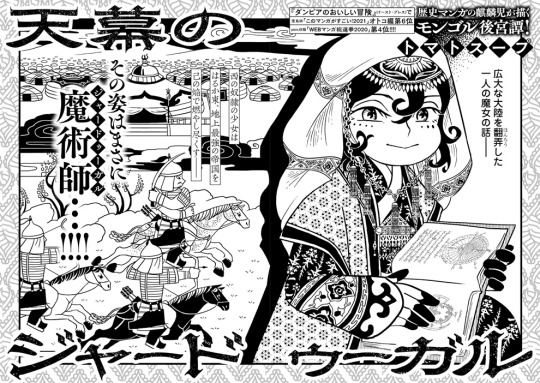
Chapter 1
We kick off with a rather poetic reference to scholars using geometry to measure the earth and the idea of trying to quantify fate. In 13th-century Iran/Persia, in the city of Tous, we meet a family looking for a domestic worker. The family is a woman, Fatima, who is newly widowed, her son, Mohamed, and her brother. A slave trader offers her some options, but they are rather pricey. So he suggests she take a little girl, Sitara, for a heavily discounted price. The slave trader asks Fatima to educate Sitara since they are a scholarly family, so she does.
However, Sitara plays dumb to ensure her value as a slave stays low. That way, no one would bother taking her to faraway lands to sell her for higher prices as she wants to stay close to her home to try and go back. Sitara tries to sneak out and runs into Mohamed, who talks to her about why he thinks learning is so great. He inspires her to pursue an education so she can have the tools to handle whatever life throws at her. Mohamed wants to travel and learn from others to find the "truth" for himself. He promises Sitara that he'll write letters to her and his mother, which further inspires her to learn to read.
The chapter ends with Mohamed leaving Tous, and the narrator tells us it was the last time Mohamed and Sitara ever saw each other.
Chapters 2-5
I'm going to speed through the rest now that we got the setup out of the way.
***SPOILERS FOR CHAPTERS 2-5***
*
*
*
8 years have passed since Mohamed left and Sitara has been pursuing an education under the direction of Fatima and her brother. While the Tous army is investigating strange activity near their borders, Fatima shows Sitara some things her late husband left behind such as books and astrology tools.
As the Mongols are closing in on Tous, Fatima and Sitara hunker down in a cellar to wait the threat out. Unfortunately, they're found, and one of the Mongol princes takes a book that belonged to Fatima's late husband. Sitara tries to stand up to him, causing her to be attacked. Fatima takes the blow, saying, "Don't touch my daughter," before passing away.
Tous is razed to the ground, and its citizens killed or driven out and forced to march to the Mongol camp. Sitara finds out that the city of Neyshabur, the city Mohamed is studying at, was also attacked. His whereabouts are unknown.
Interestingly, the Mongol prince was specifically looking for the book he took since his fiance had asked him for it. However, the book is in Persian and they are unable to read it. Sitara meets a boy who is interpreting for the Mongols in an effort to make himself more useful to avoid becoming a meat shield in battles for them. While he can speak Mongolian and Persian, he can't read. But, Sitara can. He asks her to team up with him to help each other become more valuable to their capturers. Sitara will read the stolen book, and the boy will translate. He suggests she come up with a more "elegant" or "majestic" name before presenting herself to the Mongol princes. She steps into their tent and introduces herself as "Fatima".
*
*
*
***END OF SPOILERS FOR CHAPTERS 2-5***
Some Background
Quick disclaimer, I'm by no means an expert. A lot of this is what I know and what I've experienced. I might have to make some generalizations or else we're gonna be here all day.
I feel like I’m about to overshare but I want to offer my perspective on this series. I don’t get to do this often so indulge me please lol. This background is so you have an idea of some things that influenced my perspective on this story.
For those of you new around here, I'm a Kuwaiti/Irani-American, Japanese to English translator (I speak English, Arabic, and Japanese).
What that means more specifically is that I've grown up/lived in America my whole life, visiting Kuwait when we could, until I moved to Japan after college. My parents are both Kuwaiti with Kuwaiti fathers, born and raised, but both of their mothers are Irani. They know Farsi to varying degrees of fluency as a second language. I never learned it since their first language is Arabic and that was the language they focused on teaching me while living in America. They usually spoke Farsi if they wanted to keep me and my brother out of a conversation between adults, rude. But I can sometimes pick up on some things being said. One of my best friends is Irani-American (Her name is also Fatimah! It's a ridiculously popular name) and our experiences are quite different, but there's overlap as well!
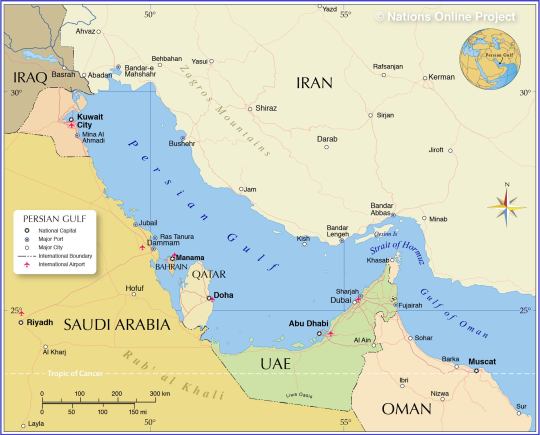
For those of you who don't know where Kuwait is. It's a tiny little country in the northern end of the Persian Gulf in Western Asia. FYI "Mina" in "Mina Al Ahmadi," which you can see on the map, means "port".
Most of our Kuwaiti relatives have Irani roots and some Turkish. There are a lot of ethnic groups in Kuwait because it started out as a port city that was a part of the Silk Road network. (I actually wanna study the Silk Road more!) So lots of people from all over gathered there. There are black Kuwaitis, those with blonde hair and blue eyes (my mom's relatives are like this), those with more East Asian features (my cousins), those with darker features (my dad's side), etc.

The Silk Road in the 1st century, courtesy of Wikipedia. You can see the route going through Kuwait. It was specifically part of the Maritime Silk Road route.
Because of all the trade, you can see the influences of many other regions in the food, clothes, language, culture, and so on.
But, yeah! History is cool.
Representation
I am indeed one of those people who is annoyingly passionate about representation. Like, I could write a whole Master’s dissertation on why it’s so important, but I’ll spare you… for now. More eloquent people have already done so anyways.
As you can imagine, I’m not used to seeing myself represented in media. And any representation I did get, was… well, how do I put this… not great? Bad™ actually. Beyond racist tbh. So can you blame me for being excited? I’m still mad about that one episode of Grey’s Anatomy when that girl whipped off her scarf/hijab to save a patient IN A FULLY STOCKED HOSPITAL!!! That would never fucking happen ;_; like imagine if you pulled your pants off to put pressure on a wound when the gauze is literally right there. I CAN’T, where do I even begin??? But I digress.
And even if I wasn’t a person from this culture, it’s just cool to see rep we don’t usually get! For example, Requiem of the Rose King is fresh in my mind right now, but having an intersex main character is not something I recall seeing. While not intersex myself, nor a noble from ye olde times, I related to Richard a lot and appreciate what the story did. I can see people from other cultures relating to Tenmaku no Jadoogar, or simply just learning new things about a culture we don’t get to see a lot of rep about. (I plan to write a follow-up post after I finish the series and talk about the rep in Rose King a bit more.)
My Localization Choices
There are no official spellings for this manga, so some explanations as to why I wrote things the way I did. Thankfully, these are all real-world names with context, so I'm not pulling nonsense out of thin air. Localizing uncommon/made-up names is... hard... traumatic flashbacks to when I had to look up official spellings for Gundam and Kamen Rider and the client didn't give me glossaries... Literally did research about Sypha Belnandes' name localization being all over the place for this blog post. Spoiler, I don’t think it was supposed to be Belnandes.

It really be like that...
Sitara - シタラ "Shitara". This isn't a name I was familiar with, so I asked my mom and Irani-American friend if it sounded like a name they knew. I wanted to say "Sitra" sounds like something that has a more "West Asian pronunciation" than the Japanese pronunciation in the manga. I was wrong and it's "Sitara" which means "star" just like what they said in the story.
Fatima - ファーティマ "Fātima". Same as my name! It's a super popular name. I katakana-fied my name as ファティーマ, which is the same, I just put the dash that elongates the sound in a different place. Why? Fatima is an Arabic name فَاطِمَة. In classical Arabic, it's pronounced like Fā-dtee-ma or Fadt-ma in Kuwaiti Arabic (the letter طِ doesn't exist in EN/JP and the best way I can describe it is it's like D+T sound.) An Irani pronunciation is more like Fā-teh-meh, which is what my grandma and Irani-American friends call me. In English, I personally pronounce my name like Fa-tee-ma, but people have various preferences. So basically, I took the Arabic and English pronunciations and katakana-fied it how I thought it would sound best in Japanese. And no one has ever pronounced my name wrong in Japan since katakana is phonetic and is actually pronounced how it's spelled. Wild I know. Meanwhile in America... *cries* I have a half-Irani-half-Japanese acquaintance who doesn't put any elongated sound in her name like ファティマ, and it's all just preference tbh. There are also different ways you can spell it in English, but "Fatima" is the most common way.
Mohamed - モハンマド "Mohanmado". This one is pretty straightforward. I think most people are familiar with this name. Also super popular. There are various English spellings as well, so I just went with a common, shorter spelling.
The title, 天幕のジャードゥーガル Tenmaku no Jadougal (this is how it's romanized on anilist), also doesn't have an official translation. It basically translates to Witch of the Marquee. Tenmaku="tent/marquee" in Japanese. ジャードゥーガル comes from جادوگر "jadoogar" meaning "witch" in Farsi. The romanization of the title should actually be Tenmaku no Jadoogar. There is no "L" in Japanese, so it often becomes "R". In Japanese, ジャードゥーガル is "Jādoogaru". Without context, it's often hard to tell if it's supposed to be "L" or "R" so I don't blame them for the mistake. But yeah, that's why I wrote it as Tenmaku no Jadoogar for the title at the top of the post. How do I contact the anilist admins about correcting that? Lol. The way my brain is short-circuiting trying to combine Japanese, English, my nonexistent Arabic reading skills since Farsi uses basically the same alphabet, and consulting my Farsi "sources"... my brain can only handle two of the three languages I speak at the same time...
1/7/23 EDIT: I asked anilist to fix the spelling of the title and it's been changed!

Shout out to Fatimah #2 for putting up with all my questions <3 Farsi has some extra letters that aren't in Arabic and I didn't know about that one...
Story
I’m starting to realize that I really dig historical fiction. Things like Requiem of the Rose King (current read, I'm obsessed), Vinland Saga, Bride’s Story (a priority TBR of mine), and Ertugrul (this one is a Turkish drama, highly recommend!) are so fascinating because we get to take a peek at what life used to be like, especially if the author did their homework. This story reminds me of Ertugrul at times since they both take place in West Asia during the 13th century, and the characters in both had run-ins with the Mongols.
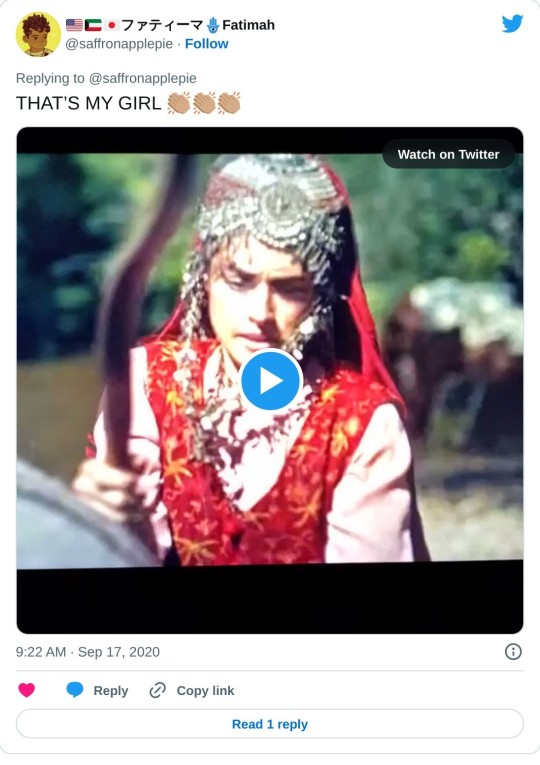
This baddie took out three Mongolian soldiers on her own!!! Well, her horse helped. Horses are great. I'm a horse girl, literally took riding lessons for ~4 years.
I found out while researching for this post that this story is in fact based on a real person in history! Here's the Wikipedia page, more info here by Dr. Jack Weatherford who wrote a book that I'm totally going to read once I can get my hands on it. I think this manga is going in a similar vein as Vinland Saga where the events are real historical events, and some characters were actual people in history, but the author is going to take creative liberties. (Check out Merphy Napier and Philip Chase's Vinland Saga discussions. They're great and Philip has a lot of historical knowledge relevant to that series that's super informative!)
The characters are lovable and interesting. I like Sitara's spunk, Mohamed's thoughtfulness, and Fatima's gentle nature, just to name a few. The relationship Sitara has with Mohamed and Fatima was very sweet. I'm interested to see how the relationship that I mentioned at the end of chapter 5 goes. Also intrigued by the bits of relationship dynamics with the Mongolian characters we have so far.
I got super excited when the theme of "learning/education" came up. Seeing how that looked back in 13th-century Persia, which was a hotspot for advances in many fields, is so cool! This story led me to do some research and asking around on topics I was familiar with, but not an expert on, and I learned things about my own culture/religion. More on learning and education later. But overall, a strong start and I can't wait to read more!
Art
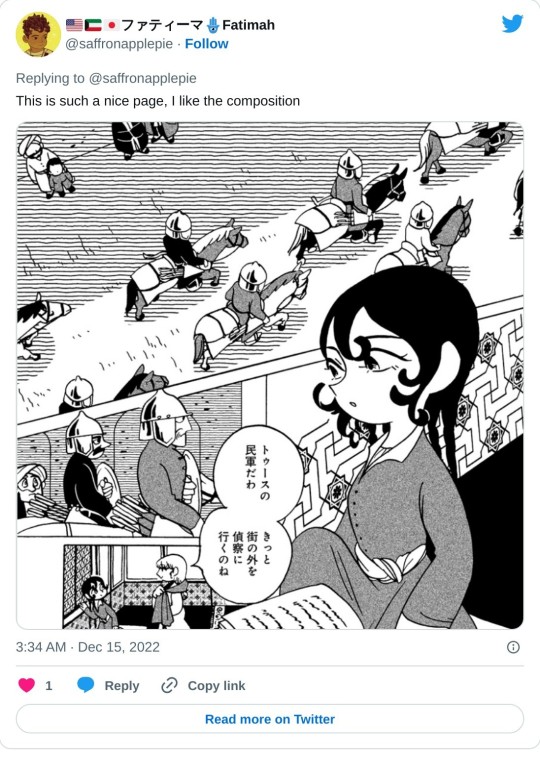
My twitter reading thread for this series
The art is very stylized, like a chibi-esque style with Persian art influences. I like the contrast between the simplified shapes and the detailed bits. I’m a big fan of inky blacks and white whites. I know all manga is black and white but this one feels like it has more contrast due to the simplified shapes. It's got tons of charm!
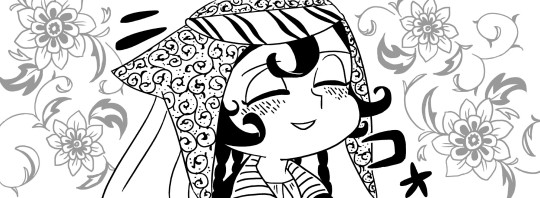

The shoujo-esque flowery background, but make it Irani-flavored✨ It looks like the rug we got in Iran!
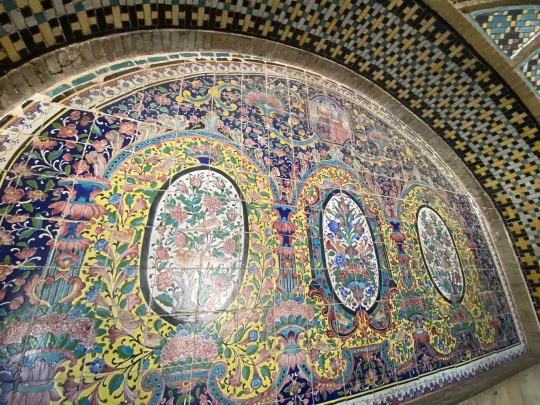
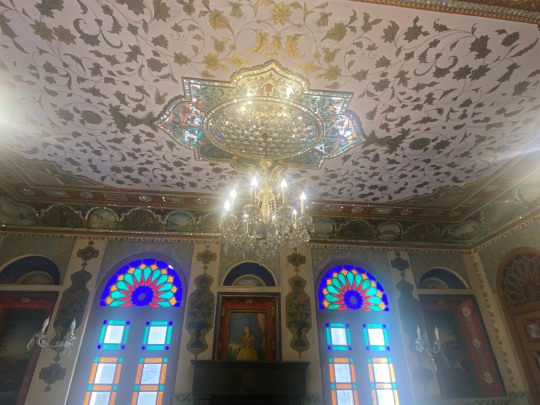
Some pictures I took at historical sites in Tehran with more examples of flowery imagery. Sorry if the image quality sucks, I didn't have my good camera :(
Culture Time!
As soon as I saw this cover, I felt a sense of familiarity. Particularly, the style of henna on her hands made me go, “Hey! That’s similar to how we do our henna!” While we also do the mehndi style henna (Is that the right term? Help) in Kuwait because of Indian influences due to longtime trade, we have another kind as well. You take the paste and hold it in your hands while curling your fingertips into it.
I had such a hard time finding pics that weren’t the intricate mehndi design ones. I would’ve just put henna on my own hands and taken a pic to show what I’m talking about, but it’s winter and it’s not good to use henna in winter because it has a cooling effect. I put henna on in winter once, and it made me so much colder. But makes you feel nice and cool in the summer! That’s why it’s traditionally applied to the head, hands, and feet, which are places you have a lot of heat dissipate from and it saps the heat away. I remember my mom doing that for me and my brother all the time when we were little during summer.
But! With the help of my mom, she helped me narrow it down. I didn't know the actual name of this style of henna. I just called it Kuwaiti-style henna lol. Apparently, it's حنه قصعة henna gasa'a, and bingo!

It doesn't show super well here, but the tops of the fingertips are also dyed like on the cover of the manga. Love that nazar ring though, so cute! 🧿

This is the mehndi style henna that people are most familiar with.

When I was little, I assumed that henna was made from soil because there are soils that can dye things a reddish color. But it's actually from a plant! The leaves are ground into a powder and then made into a paste when you want to use it.
Health, cleanliness, and hygiene are big deals in Islam. Other than being used for beauty and it’s cooling effect, henna is also used to keep oneself clean and smelling nice. It’s said that the Prophet Muhammad (PBUH) utilized henna as well.
I actually didn't know much about Iran's henna culture. When I asked my Irani-American friend whose family is from Tehran (northern Iran), she said she wasn't familiar with any. But like Kuwait, Iran has a lot of ethnic groups. It's also a large region (it used to be a whole empire and all that, too), so there are definitely people who do use it!
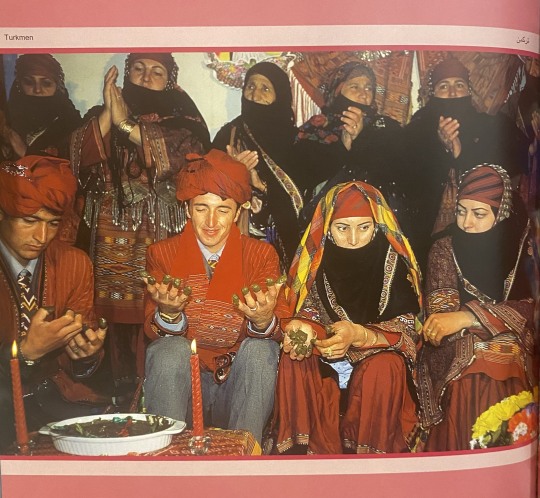
Turkmen Iranis, dying their fingertips with henna, exactly like in the manga! My family are Turk, too! (From a book I picked up a few days ago in Iran, "Nomads: Migrating with Swallows". What a pretty title...)
The clothing of the characters also felt very familiar. The cover of volume one reminded me of this picture:
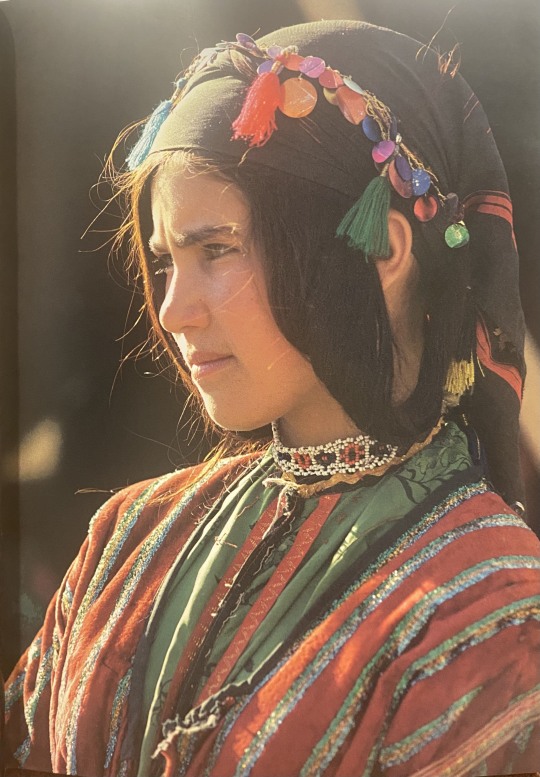
Maku Kurd girl ("Nomads: Migrating with Swallows")
Iran grows tons of fruit, herbs, and flowers, famously roses! Rose water is a staple we pretty much always had at home.
Rose water is used for medicinal purposes and has antibacterial and anti-inflammatory qualities. People often wash up with it since it has a lovely fragrance and makes you smell nice. It's also used in foods and desserts or added to drinking water for flavor and health benefits.

Sitara bringing Fatima rose water. It looks just like this 12th-century rose water container. We still have containers like this nowadays and I actually used one to wash my hands recently.

Faloodeh (Persian Lime and Rose Water Granita With Rice Noodles), Bastani Sonati (Saffron and Rose Water Ice Cream), in Kuwait we say Sharbat Nimil but apparently, it's Tokhm-e Sharbatie in Iran (Rose Water and Basil Seed Drink) Fun fact: Sharbat Nimil means "ant drink" because the seeds look like... ants... and the thought freaked me out as a kid, I never wanted to drink it. I thought my aunt was messing with me but my parents said, "Yeah, no, that's actually what it's called."
Dates! Another staple. Always have some in the house.
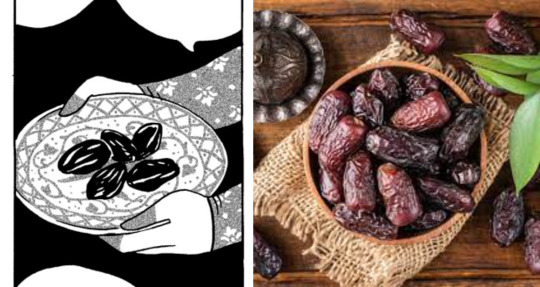
These are ripe dates. We call them "tamar". Sweet, delicious, amazing.
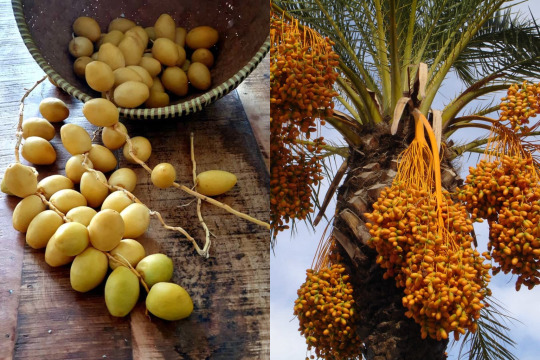
These are fresh dates! We call them "khalal". Sweet, crunchy, amazing.
The architecture was also, you guessed it, familiar as well. Particularly the courtyards! It really took me back.


Courtyards! My Irani grandma (also Fatima, I told you it was a popular name...) had a courtyard home in Kuwait too, but less fancy, and she had a huge date tree instead of a fountain. We would play there all the time when we visited. Also reminds me of the houses in some of the Irani movies I've seen.
Let's Talk Religion
I know religion is historically always a fun and totally not divisive topic, but we're all going to be civil and discuss stuff like adults. I'm not trying to convert anyone, I swear. Chasing after people and forcing religion down their throats is actually frowned upon in Islam believe it or not. I’m also not saying it’s a better religion than others or anything of the sort so don’t come for me. It's just relevant to the story and I'm hoping we can interact in good faith, so let's talk.
I am NOT a scholar, this is just what I know and my understanding so please don't quote me. I probably have to gloss over and simplify a lot because there's... too much.
There are various interpretations of Islam. The Quran, to my understanding, is meant to have its interpretations evolve over time to address the issues of people no matter the time or place. Issues faced centuries ago might not be as pressing now, or we might have new issues today that weren't a thing back in the day. Iranians mainly practice Shia Islam, which is also the sect I know most about so that's what we're focusing on.
Islam is the fastest-growing religion. It's also quite misunderstood due to hate/misinformation, AND — I'm gonna just say it, there are Muslims who have skewed interpretations of Islam's teachings. Am I the perfect Muslim and my interpretations are law? I didn't say that, obviously not. But I'm going to call it how I see it. I don't take sides and I'm not going to defend someone just because they identify as Muslim if they're doing stuff that doesn't make sense (that would be un-Islamic and just... dumb imo). But anyways, there are a few points I’d like to touch on so we all have a base understanding.
Many people think that Allah (SWT) is “the Muslim god” but actually, he’s the same god that brought down the Bible and Torah. He's just... God. This is why you’ll see a lot of crossover between these religions. And Christian Arabs, for example, say Allah because that’s just God in Arabic.
Why did God come up with different religions? It’s my understanding each religion was what the people needed at the time. (Also because of the next point)
Muslims DO believe in the original Bible and Torah, but historically there's evidence that these books have been altered by people over the years. (Again, I'm not saying your religion is wrong if you're Christian or Jewish. You do you.) Then what about the Quran? I’ll actually address that later.
Muslims DO believe in Jesus. We just think he's a prophet instead of the son of God or God.
Cool? Cool.
Now to address some religion-related things that came up in the story.
The part where there is the selling of slaves made me raise an eyebrow since slavery is not allowed in Islam, because, duh.
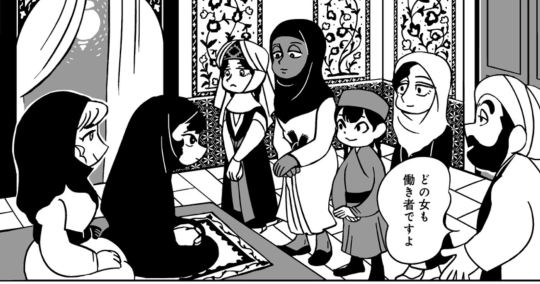
I did some research and asked around. I was able to talk to my Irani-American friend's aunt when I visited them during my Iran trip last week since she's studied this kind of stuff. She joked that I should save myself the trouble and not touch the slavery topic, especially with Americans since it's... like... a super touchy topic. But this is an important topic and we should talk about important topics instead of shying away from them — respectfully, of course. And maybe we can all learn something. It was a perspective on slavery that was very different from what I'm used to hearing about in America. She essentially confirmed what I was thinking.
The Quran envisions the ideal society as one in which slavery no longer exists. Since slavery was such a widespread issue around the whole world back in the olden days, (it still is an issue today, but I'm assuming it was worse back then) it was unfortunately unrealistic to try and abolish it in one fell swoop. Again, this isn’t just abolishing in one country or region, but tackling the issue worldwide. So, in Islam, the idea is that there are steps in place to phase it out. For example:
No free people can be enslaved, duh.
People cannot be enslaved due to debt or crime.
You are encouraged to help slaves buy their way to freedom by giving them money to do so or buying them to free them.
If you are in possession of a slave, you should free them.
If you house a slave, you must treat them well.
This last one is just an interesting thing I didn’t know about that I saw in my research and it came up in the story — Slaves get half the punishment for a sin than if the same sin was committed by a free person.
I wondered why then, did Fatima's family, not free Sitara and the other slaves? It didn’t look like they had anything stopping them from running away either. Sure, Sitara got scolded by another slave for trying to leave, but she could have tried again and run away. The other slaves in the story seemed like they wanted to/were okay with staying, even though they did wish they could go home and felt homesick. So what’s up?
It's my understanding that back then, it was common for people to take slaves into their families, offer shelter and educate them. It was a way to take them off the streets, away from the slave traders, and keep them safe.
Why not just take everyone back to their homes? Various reasons. They might be in danger if they try to go back. They might not have anywhere to go back to. Also, this was the 13th century. It's not like they could just hop on a plane and go home. There's also no law enforcement the way we have today. Hell, even with all the local and international law enforcement of today, slavery is still a major issue.

Sitara wants to go home but has no home to go back to.
Is this ideal? As I mentioned, ideally slavery wouldn't even be a thing. I’m pretty sure we can all agree slavery=bad. I'm not here to argue that. But I also think it's important to try and understand what things were like back then and why people did what they did. A lot of times I see people measure things with their standards that were developed in modern day, with their own life experience. You need to be careful when doing that. I'm sure in the future, people will look back at us like, "Damn, y'all lived like that???"
Perhaps, this was the best the average person could do. Try to protect them and offer them shelter and an education. As long as we don’t live in an ideal world, we need to consider various solutions to issues. So this was an interesting way to try and tackle the issue given the time and circumstances. It’s rather different from what I think most Americans know about this subject.
Did everyone do this? I'm going to say probably not. Terrible people always exist. Plus there are plenty of people who say they practice a religion, but cherry-pick what they want to follow, do the opposite, have distorted understandings of its teachings, or just downright weaponize religion to suit them. That's a whole other discussion though, so I'll leave it there.
I would like to read more about this topic though, so if anyone knows any sources, let me know!
The First Word From God - "Read"

"Slave or not, it is a Muslim's duty to seek knowledge, as stated in the hadiths."
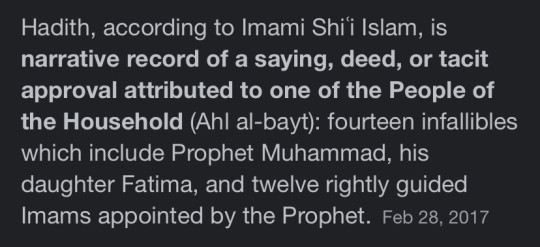
What's a hadith? Here you go. Also, this is the OG Fatima, Lady Fatima (PBUH).
When God first sent the angel Gabriel down to Prophet Muhammad (PBUH), his first word to him was, "read". Education and seeking knowledge are SUPER important in Islam, and should not be kept from anyone regardless of race, gender, etc. Seeking knowledge will make you a more rational, well-rounded person. Knowledge in this context is broad and all-encompassing. It doesn't only mean religion, math, and science, but philosophy, art, and so on. Literally anything. I hope I don't really need to convince anyone that education is a human right and empowering and all that stuff, so let's keep it moving.
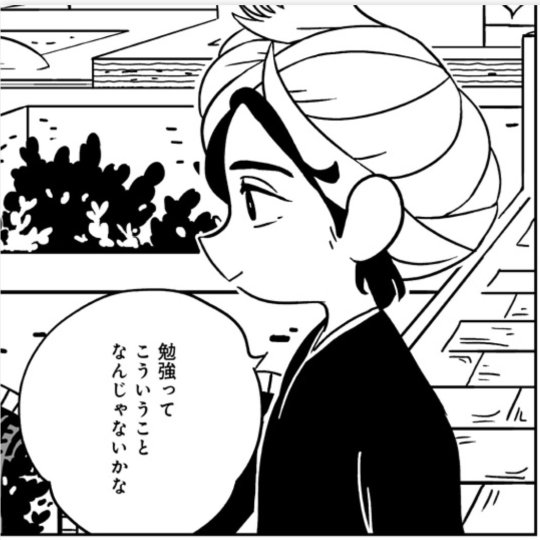
"Isn't that what learning is all about?"
To address this earlier point:
Muslims DO believe in the original Bible and Torah, but historically there's evidence that these books have been altered by people over the years. Then what about the Quran?
Tbh, I hesitated to include this part because people might misinterpret or take offense. To reiterate for the umpteenth time, I'm not saying your religion is wrong if you're Christian or Jewish. You do you. We’re actually told to respect believers of these religions. I swear!
So, yeah. Moving on.
Another reason seeking knowledge is an obligation in Islam is so that you are able to read the Quran for yourself. When loads of people read it, memorize it, and are familiar with it, any changes will not go unnoticed. This is to stop people from weaponizing and distorting the Quran's teachings. And this is why there is only ONE Quran, and not multiple versions (I’m not talking about translated Qurans).
In general, having knowledge about things makes you less susceptible to being lied to or misled, regardless of the topic. Unfortunately, I'm in the camp where I believe not enough people do their own research and reading. And again, I don't just mean religion, but everything. That kind of thing takes effort, and effort is hard.
Go read!
You're Still Here?
Like the first-place winner for the Male Category, The Summer Hikaru Died, which I’ve been pushing on anyone who will listen since volume one hit bookstores in Japan, Tenmaku no Jadoogar: A Witch's Life in Mongol deserves to win the Female Category. From what I can see so far, it’s well researched and written with love. I'm looking forward to seeing how this story unfolds and I may add more thoughts as we go.
Volume 2 is due to come out February 16th, so I’ll be tweeting my thoughts on my reading thread. The link to this post is on Twitter here if you want to share it there. EDIT: Volume 2 post is up!
If there's anything else you'd like to see me discuss or expand on, let me know and I'll see what I can do. I'd love to hear what others think!
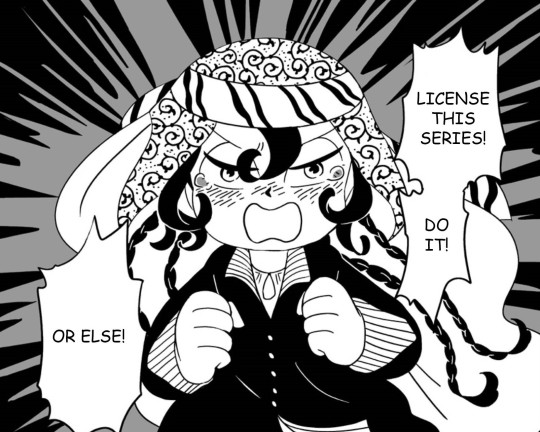
I await your email publishers, my resume is ready... [email protected]
🧿🪬🧿🪬🧿🪬🧿🪬🧿🪬🧿🪬🧿🪬🧿🪬🧿
—————————–
If there’s any Japanese-only manga you want me to check out, let me know! No promises, I’ll only read what I’m interested in, but I’ll take suggestions into consideration. Preferably, shorter manga or newer manga with a few volumes out since I like to take breaks from longer series I’m reading :)
#天幕のジャードゥーガル#Tenmaku no Jadougal#A Witch’s Life in Mongol#manga recs#manga#漫画#おすすめ#Tenmaku no Jadoogar#manga recommendation#kono manga ga sugoi#このマンガがすごい#manga discussion#shoujosei#josei#josei manga
279 notes
·
View notes
Note
Any good non fic recommendations?
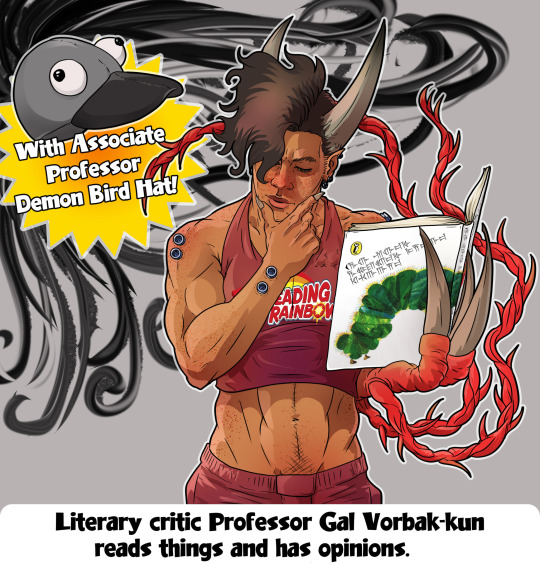
That depends on your interests, of course. I'm particularly interested in the Roman Empire at the transition point from Republic to Empire (which could also explain my enjoyment of Warhammer, but there may be other reasons for that). And here especially military and everyday culture. I'm less interested in politics, but of course a lot of private matters were also political at that time.
Although I have to admit that this point in time is very soft and fluid. I'm just as interested in the Bellum Sociale and the whole Sulla/Marius tragedy as I am in the later British campaigns. I'm really not being very scholarly here.
A few good books for starters here are:
SPQR by Mary Beard. A quick and easy read and a tour de force through roman history from the kings to the fall of the emperors. I found it entertaining, but you should start with it, since if you are already deeper into the subject it doesn't offer much new insight.
A few books by my favourite experimental archaeologist, Marcus Junkelmann. I don't know if his books were translated into English, though. This guy builds and uses all the equipment he and his colleagues dig up! He marched across the Alps and along the Limes in legionary equipment, fought as a gladiator (various styles) and trained military horses the way the roman legion did. He's fucking awesome!
Gladiatoren. A very in depth look on the equipment, its ties to the development of military weapon and armour from the same time and on the living conditions of gladiators. Very good! If you can read/understand German, this book's a must have!
Die Reiter Roms, part one to three by the same author. So many details, so much context for archaeological finds! So many practical tests! Loved that. If you want to know why a letter from London to Rome took only a week in the first century? This is your book! Interested in the mounted police of the north-eastern border? This book.
A lighter read: 24 hours in Ancient Rome by Philip Matyszak. Exactly this. A whole day at augustinian Rome. With all the religious, mundane and political stuff that happened. You want to know more about roman firefighters? The system of political influence? Medical treatments for the poor? That's your book!
Some more military history: Roman Britain's Missing Legion - What really happened to IX Hispana by Simon Elliott. So much detective work and a lot of context, especially with the fleets, too. Liked that!
That's just a small slice of the cake - that field is vast and so much fun.
But if you are interested in some very good military fiction (backed by the most recent archaeological finds - so constantly changing, I'm afraid), you should absolutely take a look at the "Under the Eagle" series by Simon Scarrow. Very Warhammer in its own way. Great characters! The hard-ass Centurio Macro and the survivor of roman palace politics, young scribe-turned-Optio Cato become unlikely friends. And have lots of adventures. Blood and stuff.
And here's some roman AU Lucius as a treat.

23 notes
·
View notes
Note
Can you tell me about your other Swtor Ocs?
By 'other' I'm gonna assume 'ones who are not my main lads Cas and Khel' haha. So let's see....

Damaskh, aka Cipher Twelve: My Imperial Agent, who actually doesn't follow the game's IA storyline. Genderfluid half Zeltron, half Sith pureblood. His specialties are disguise and infiltration, primarily for longterm undercover missions. He's a background character - I really don't have a lot of actual story or plot for him, except when he pops up occasionally in Khel's world, but I do find his 'casual but deadly' manner to be immensely entertaining.

Darius Serapis: My canon Republic Trooper, and Caspian's older brother. He's a die-hard Republic loyalist with a no-nonsense attitude, sometimes harsh and unyielding, but he's got an excellent reputation among the lower ranks as a commander who never leads from the back or leaves a soldier behind. He and Cas do share a fierce family loyalty to one another, even if they disagree on a lot of things.

Emryn Solari: A Republic medic who's highly Force sensitive but actually declined to join the Jedi, preferring to serve as a field medic in the military. He often comes off as naive and mild-mannered, but he's surprisingly level-headed when working under fire. He was Caspian's best friend when they were growing up on Corellia, and he joins Cas' crew as their medic during Chapter 3 of the JK story (basically replacing Doc, who doesn't join up in my canon).

Maahes: A Sith battle prodigy who defected to the Jedi at the tail end of the Great War, and who is now a respected if somewhat maverick Jedi Master. Stern but kind, he has an understated sense of humour which I adore, and is often tasked with chaperoning groups of Jedi-in-training on field trips. He's also Caspian's former mentor, and something of an unspoken father figure for Cas.

Shod'al Kur, aka Darth Syphon: Similar vibes to the Sith Inquisitor story, only a few generations earlier, aka former slave who clawed his way to power and now sits on the Dark Council. He's far more about cunning than brute force, and always has a feel out for the pulse of how things are going in the Sith Order. He's a newer OC, so I don't know a lot more about him yet - but I do know that he went through Sith training with Maahes, and the two became friends, then lovers, and while Maahes defected, Shod'al refused to give up his place of power and remained in the Empire.

Vanirr Kel-Su - My canon-ish Jedi Consular. He embodies everything the Jedi are supposed to be, in the layman's eye - good and bad. He's calm and scholarly, an exceptional diplomat and excellent at sneaking around to find the path of least violence, both literally and figuratively. Unfortunately, he knows he's all of this, and so he's also quite preachy and thinks he can handle anything, especially all those dangerous artefacts out there. He and Caspian went through Jedi training together - they didn't get along then, and they don't get along now.
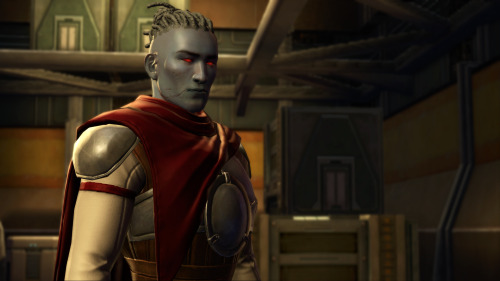
Ibis: A non-canon-story smuggler who's really out there just to cause some chaos and then sit back with popcorn. They live for danger and entertainment - credits are just a bonus. Like Damaskh, more of a background character till they deign to tell be more about themself.
#swtor#swtor oc#star wars the old republic#imperial agent#republic trooper#sith inquisitor#jedi consular#jedi master#star wars oc#kem answers#kem rambles#kem oc#i know i still have another ask from you i will get to it SOMETIME xD#swtor:damaskh#swtor:emryn#swtor:darius#swtor:maahes#swtor:shod'al#swtor:vanirr#swtor:ibis
13 notes
·
View notes
Text
Books That Rocked My Shit and Should Be Added to Your 2024 TBR
i love love talking about the books i’ve read and as the year approaches it’s close, here is a list, in no particular order, of books that really did numbers on me and should be added to a new year tbr!! it’s a mix of fiction, poetry, and nonfiction/memoir
1. Babel: Or the Necessity of Violence: An Arcane History RF Kuang
Robin Swift, a Cantonese orphan, is adopted by an Oxford professor and trained for years in linguistics and languages so he can become a student at Oxford University at the Royal Institute of Translation (Babel). Babel handles all of the British empires linguistic concerns and, most importantly, it’s magic. Silver bars are inscribed with words that mean the same thing in different languages and the meaning lost between the translation enchants the bad. At Babel, Robin befriends his class, three other non-traditional Oxford students, and starts to see how Babel is used to serve the empire. He gets involved with the Hermes society, an anti-imperialist secret society, and gets caught between them and Babel as Britain declares war on China.
You know this book was gonna be on this list. It’s actually kind of cheating because I read it for the first time last year but I did a reread this September and my god, it’s so stellar. It’s a very fresh concept that revolves around the classical and the tension between those two is just delicious. My post structuralist heart that believes our world is composed of language was just beating out of my chest this entire book. Oh!! And don’t even get my started on the alternate/sub/second title!!!!
2. Why Religion? by Elaine Pagels
Elaine Pagels is a scholar of religion who has done extensive research into early Christianity and Gnosticism, and is known for her involvement and study with the Nag Hammadi documents, a collection of texts discovered that are thought to be early Christian and gnostic gospels. Using her robust academic background, Pagels explores her personal relationship to religion through a series of essays in this memoir-esque book. She writes about her time being religions and non-religious as well as the profound hardship and grief that she experienced throughout her life that led her to ask “Why religion?” and find her own answer.
This book is phenomenal. I was introduced to it in a religion course I took this semester and it has fundamentally changed my relationship to religion, even as someone who considered themself to be more or less an atheist. Pagels’ writing is intelligent and poignant but not difficult to understand. This isn’t a scholarly work and I would call it more of a rumination than an argument. The main note I have for potential readers is that it is very Christo-centric and also doesn’t spend much time with biblical canon, but considering this is a memoir and not an attempt to rationalize religion for anyone other than Pagels herself, I was not put off by it.
3. Bad Fruit by Ella King
Chronicling Lily’s life after graduating high school and starting at Oxford, the book revolves around her relationship with her mother. Her mother, from Singapore and with a troubled past that Lily begins to understand, becomes increasingly erratic and unhinged. As she does, Lily follows in her footsteps as she seeks to appease her mother while also trying to break free from her control. The central mage in the book is a cup of spoilt orange juice that Lily always tastes first to make sure it’s right for her mother.
First off, fruit. You know I’m always down bad for a book with fruit is the main motif! This is such a fantastic book exploring mother-daughter relationships, inherited trauma, and cyclical abuse. It’s devastating but never heavy handed and the writing is really fantastic. I think about this book all the time and how every character is so well written and so intensely fallible but never denied humanity.
4. She Who Became the Sun by Shelley Parker-Chan
A fictionalized retelling of the Hongwu Emperor, the story follows a young girl who assumes the identity of her brother, Zhu Chongba, after he dies. The original Zhu was promised greatness and in the wake of his death and to survive alone, the new (and perhaps real) Zhu joins a monastery. The story is set during Red Turban Rebellions against the Mongolian Yuan Dynasty and after many years at the monastery, Zhu joins the Red Turbans and rises among the ranks all while she attempts to conceal her deception. The story also follows General Ouyang, a Mongolia general, as he struggles with his own status among the Mongols and his hatred for Zhu. The book follows the interpersonal struggles of the characters while the overarching war between the Red Turbans and the Mongols rages on and, often, intersects with the personal.
I read this book in two days and was just beside myself. My synopsis can’t even begin to cover the complexities of this book, it is trusty one of my favorites I’ve ever read. It is SO good. There were moments where I was left gaping at the page, I was so enthralled!! I’ve heard some people didn’t vibe with the pacing of the book because it spans so many years, but I read it’s o quickly that it wasn’t an issue for me. The way that gender and sexuality are handled in this book was so well done and very much a reminder that queerness and the experiences that come with it aren’t always able to be articulated, especially by contemporary language and labels. And the parallels between characters!! Zhu and Ouyang!!! I really don’t think anything I can say can do this book justice because it’s just fab. Really spectacular!!
5. Bright Dead Things by Ada Limón
Ada Limón is the current poet laureate of the United States and this is an earlier collection of hers. This poetry collection explores identity, place, and loss with an overarching feminist oomph. The books is in four sections, each embodying a different experience or theme but all interconnected. Limón’s writing is clear and vivid and her command of language is incredible.
This collection is fabulous! Although not my usual pick, Limón’s style radiates off the page and her skill is so obvious in every poem. She is so aware of space in all her poems and every word is picked with precision. Even in the moments of loss and grief that Limón writes about, her optimism is tangible and infectious. “How to Triumph Like a Girl” is one of my favorite poems ever and seeing it in context with the rest of the collection gives it so much more life. If you’re new to poetry, I would definitely check this out!! If you’re a regular poetry reader, you should also check this out!!
I have a million more books I want to talk about but this feels sufficient!! If you end up reading any of these or already have, PLEASE talk to me about it!! wishing you all a joyous and well read new year <3
#book rec#book rec list#poetry#nonfiction#fiction#babel an arcane history#why religion#bad fruit#she who became the sun#bright dead things#ada limón#rf kuang#ella king#elaine pagels#shelley parker chan#marble woes
22 notes
·
View notes
Text

Interrupting my DA:V squealing to say that in honour of the gameplay drop I posted a chapter early. This au has no need of a Veilguard but I dooooo. Happy Dragon Age Hype Day!
Read from the beginning
Rating: M | Category: M/M | Words: 50 928 | Chapters 23/29
Summary:
When Magister Dorian Pavus' expedition meets unexpectedly with a clan of unhappy Dalish elves, First Taren Lavellan may be the unhappiest among them. Unhappier still to be put to the task of helping to see his quest through. This is the tale of how a fortnight in the forests of the Free Marches can change everything.
Chapter 23: Song and Stone
Snippet:
Taren’s head shot up from his notebook, his strange eyes wide. He hopped to his feet and moved to the wall beside Dorian, where a slab of stone had receded to reveal a large, clunky looking iron lever within a slot in the wall beside it.
Cautiously, the elf lifted a hand to the lever and pulled. Three torches scattered in odd, seemingly random places around the circular chamber lit up.
Dorian jumped to his feet. He examined the stone he’d leaned into, noting the texture around its edges and the slight differences in its colour. “A hidden switch,” he muttered, “That was my next theory, of course. Just testing it out,” he threw a wink and a grin Taren’s way.
The elf shook his head with an amused half-smile. “You leaned on the wall and the stone opened,” he noted with crossed arms.
“You know, approximately eighty percent of scholarly work is taking events like this one and writing about them as though it was your stalwart intention all along.” Dorian gave a chiding sigh. “You’d make a terrible academic.”
“Mhm, so Tevinter academics are full of shit? I’d never have guessed.”
Funny elf, swearing like that in his rolling voice. Dorian laughed along, and wondered vaguely how he’d come to sound so Marcher .
“Yes, yes, we’re an empire built on lies. Still, if the results are valid…”
Across the room, in a roughly parallel spot, Dorian found another odd stone. Tentatively he pressed against it, until it ground and moved against the rough stone wall, clicked in, and revealed to its side another lever. Once again, a random assortment of torches lit themselves upon the walls, yet with them went the light of one of those which had been lit before.
#solving classic torch puzzles!#do we think there will be torch puzzles in da4??#dragon age#dragon age fanfiction#da:i#dragon age inquisition fanfiction#dorian x lavellan#taren lavellan#dorian pavus#pavellan#the hunter the snake and the fox#my fic#my writing#ok back to screaming about new shit
9 notes
·
View notes
Note
regarding the…Strabo passage from the biography. the one that you tagged as “the sea that defines the contours of the man”. i agree so much…
from a narrative perspective it has always seemed to me that water (in its various forms) is a very very appropriate theme in Agrippa’s life….Agrippa, born-feet-first, reluctant to leave the water of the womb…Agrippa, ager-ripa — the field and the river bank, the land that meets the seashore….his construction of aqueducts and clearing of sewers, the veins of the empire that run above it and beneath it, one who stands firm upon the uncontrollable waves and then steps back, returns and leads the tamed waters of the empire into the cities and baths and fountains…Augustus’ affiliation with Apollo and Diana mirrored by the steadfast sea — the sea that reflects the brilliance of the heavens in the day and the tides that shift with the moon at night….even the scattering of his ashes from the mausoleums by the visigoths 400 years later, washed away by wind and rain….:”
(Also. On the point of the name etymology. Ager and ripa aren’t actually a proper pair of words for his name’s etymology but it struck me because it is so symbolic….if you’re interested in more scholarly interpretations of his cognomen in poetry, I’d recommend “M. Agrippa in Horace 'Odes' 1.6, Author(s): Francis Cairns”!)
hi anon! i agree entirely with water being a running theme throughout agrippa's life - all the points you've made are really intriguing, and may or may not have given me some ideas for my wip (thank you ashgfkhsdj). i didn't know about his ashes being scattered by the visigoths - that's fascinating. do you have any further sources/articles you'd recommend in regards to it?
juxtaposing his water motif - and by extension the tides, and the moon - with octavian's association with apollo and the sun (very off topic but one of my favourite examples of this is suet. aug. 94.6) is something i think about. a lot. how they reflect and mirror each other; how agrippa's cast into shadow (ish) by octavian's 'brilliance', so to speak... ough. ow owie. and while we're on the subject - agrippa offering to raise octavian to the heavens in the pantheon:

(cassius dio 53:27 my beloved)
kind of the sun-moon thing again. especially with their statues in the anterooms, mirroring one another - as it resembles the heavens, they are heavenly bodies themselves? augh.
sorry, off topic. going back to the water thing - in addition to the contemporary sources while he was actually alive, he's also been depicted more recently on two panels of the trevi fountain:


(i really like the first one lol. look at him go. point boy.)
and even here, he's shown discovering the source of the aqua virgo. water as veins and the empire as a living thing, and agrippa in the middle of it all (even now!).
that article was really interesting, thank you so much for recommending it. i personally know very little latin/greek so i'm sure a lot of it went over my head, but still! the etymology of his name is definitely something to look into more closely. ager-ripa might not be 'proper' but i agree - the symbolism, the symbolismmmm. augh.
#asks#sorry this is long and not very coherent. however. unable to be normal about him.#thank you so much for the ask !!!!! lots to think about ough........#marcus agrippa#agrippa#guys tag
17 notes
·
View notes